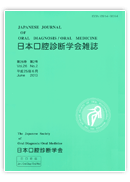Volume 30, Issue 2
Displaying 1-15 of 15 articles from this issue
- |<
- <
- 1
- >
- >|
Original
-
2017Volume 30Issue 2 Pages 151-156
Published: June 20, 2017
Released on J-STAGE: June 24, 2017
Download PDF (684K) -
2017Volume 30Issue 2 Pages 157-167
Published: June 20, 2017
Released on J-STAGE: June 24, 2017
Download PDF (1205K) -
2017Volume 30Issue 2 Pages 168-175
Published: June 20, 2017
Released on J-STAGE: June 24, 2017
Download PDF (1340K) -
2017Volume 30Issue 2 Pages 176-182
Published: June 20, 2017
Released on J-STAGE: June 24, 2017
Download PDF (500K)
Clinical Reports
-
2017Volume 30Issue 2 Pages 183-186
Published: June 20, 2017
Released on J-STAGE: June 24, 2017
Download PDF (704K) -
2017Volume 30Issue 2 Pages 187-192
Published: June 20, 2017
Released on J-STAGE: June 24, 2017
Download PDF (805K) -
2017Volume 30Issue 2 Pages 193-196
Published: June 20, 2017
Released on J-STAGE: June 24, 2017
Download PDF (513K) -
2017Volume 30Issue 2 Pages 197-202
Published: June 20, 2017
Released on J-STAGE: June 24, 2017
Download PDF (934K) -
2017Volume 30Issue 2 Pages 203-205
Published: June 20, 2017
Released on J-STAGE: June 24, 2017
Download PDF (334K) -
2017Volume 30Issue 2 Pages 206-211
Published: June 20, 2017
Released on J-STAGE: June 24, 2017
Download PDF (749K) -
2017Volume 30Issue 2 Pages 212-215
Published: June 20, 2017
Released on J-STAGE: June 24, 2017
Download PDF (517K) -
2017Volume 30Issue 2 Pages 216-222
Published: June 20, 2017
Released on J-STAGE: June 24, 2017
Download PDF (1158K) -
2017Volume 30Issue 2 Pages 223-225
Published: June 20, 2017
Released on J-STAGE: June 24, 2017
Download PDF (390K) -
2017Volume 30Issue 2 Pages 226-230
Published: June 20, 2017
Released on J-STAGE: June 24, 2017
Download PDF (684K)
Original
-
2017Volume 30Issue 2 Pages 231-236
Published: June 20, 2017
Released on J-STAGE: June 24, 2017
Download PDF (294K)
- |<
- <
- 1
- >
- >|
